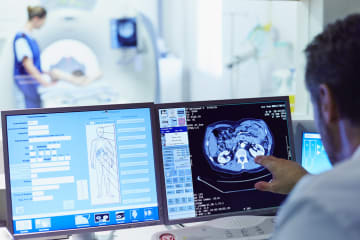How Effective Communication in Nursing Makes a Difference

One of the more critical parts of nursing school is when you get to practice your nursing skills in a real patient setting — starting an IV, performing an assessment on a baby, or helping a patient walk for the first time after surgery. But not all nursing tasks require your physical, hands-on skills. One important example is effective communication skills in nursing, which are not just important to learn, but also to practice and refine throughout your career.
By learning about the core types of communication — verbal, nonverbal and active listening — as well as strategies to improve your communication skills, you’ll have a better understanding of why communication skills in nursing are important.
In This Article:
- Why Is Communication Important in Nursing?
- Overcoming Communication Barriers
- Communication Techniques Nursing Students Should Know
- Refine Your Communication Skills in Nursing
- Develop Nursing Skills at GCU
Why Is Communication Important in Nursing?
Effective communication in nursing is important for the nurse–patient relationship as well as for professional relationships in the healthcare setting. Nurses must be able to effectively communicate vital information — such as changes in a patient’s blood pressure or unmanaged pain — to doctors and other members of the healthcare team.
Focusing on improved communication, among other skills, can increase nurses’ emotional intelligence, which leads to improved patient safety and higher-quality care.1 Effective nursing communication also strengthens trust in nurse–patient relationships and leads to better patient outcomes and higher satisfaction.1
Furthermore, effective communication can improve teamwork and increase job satisfaction among healthcare providers.2 Nurses and members of the healthcare team who practice effective communication are found to enjoy more trusting relationships with their coworkers, and they are also less likely to experience burnout and turnover.2
Types of Communication Skills in Nursing
Three common skills to practice that enhance your effectiveness in communication are verbal, nonverbal and active listening. Incorporating the right amount and timing of each of these can help you effectively communicate with others.
1. Verbal Communication
Verbal communication, or your spoken words, is how most communication happens.3 Remember to think before speaking, use language appropriate for your audience, be precise and concise, be prepared to clarify, and speak clearly.
Nurses should use clear and compassionate verbal communication techniques when speaking with their patients, their families and colleagues, and they should convey appropriate information to ensure understanding of their plan of care. For example, when explaining a medication schedule to a patient, nurses should use simple, jargon-free language and verify that the patient understands when and how to take their medicine by having them repeat the instructions and schedule.
2. Nonverbal Communication
Your actions often speak louder than your words. Your nonverbal communication — body language, facial expressions and gestures — can drastically change how someone receives information from you.3 If you are standing with your arms crossed while discussing a patient's treatment plan, that posture may come across as defensive or unapproachable. By contrast, if you pull up a chair and sit at their bedside to explain the process, and how it will help your patient feel refreshed and prevent complications of poor hygiene (such as infections, bed sores and mouth sores) the same information will be much better received.4 Furthermore, maintaining eye contact and nodding while a patient speaks can reassure them that they are being heard and valued.
Nonverbal communication is also invaluable when having difficult conversations with patients or their loved ones. Holding a patient’s hand while sharing information can help your patient to know that you care. Leaning forward shows attentiveness and empathy, without the need to say a word.
3. Active Listening
The third type of communication is active listening, which can be a combination of verbal and nonverbal communication. If you nod your head gently while the patient expresses their feelings, it lets them know you are listening. Allowing your patient to finish their thought before responding, and using your response to assure the patient that you heard and understood their concerns, is part of active listening.
Active listening for nurses involves fully concentrating, understanding and responding to patients, ensuring they feel heard and validated. For example, when a patient expresses concern about a medication’s side effects, a nurse practicing active listening might say, “I hear that you’re worried about the nausea you’ve been experiencing. Let’s discuss this with your doctor to find a solution.”
Practicing these three key communication skills during your time at nursing school can give you a head start on improving your effective communication with patients and coworkers.
Overcoming Communication Barriers
Some of the most common barriers to effective communication in nursing are cultural differences, language barriers and emotional barriers. Asking about and understanding your patient’s culture and preferred language can help you avoid mistakes in communication. Better yet, it can help build trust with your patient because you acknowledge and respect their cultural differences.5
Several tools and strategies are available to overcome some of the common barriers to effective communication. Most employers provide cultural competency training, which should highlight the many diverse cultures within your community. The timely and appropriate use of certified language interpreters, rather than asking a family member to translate medical information, is a best-practice technique nurses should be comfortable using in their daily work.
As we continue to see improvements in artificial intelligence and machine learning models in healthcare, the use of translation apps can make communication in different languages and cultures easier and increasingly seamless.
Communication Techniques Nursing Students Should Know
There are nonverbal and verbal communication techniques nursing students should begin implementing now to maintain professionalism in their future workplace. Here are some examples:
- Eye contact
- Open body posture
- Simple and clear language
- Practicing empathy and patience
- Providing regular feedback and clarification
Refine Your Communication Skills in Nursing
In addition to your clinical nursing knowledge and skills, effective communication is equally important to learn and practice. Without effective communication, caring for your patients and creating a positive and supportive work environment becomes more difficult. When combined, the key skills of verbal, nonverbal and active listening techniques can help ensure that the right information is shared at the right time and in the right way.
Continuous improvement of your communication skills is encouraged throughout your nursing career, not only to provide better patient care, but also to foster continued professional growth and leadership in nursing.
Develop Nursing Skills at GCU
From day one in Grand Canyon University’s accelerated BSN program, you’ll practice your communication skills in nursing with classmates, faculty and patients, especially during your clinical experiences.
1 Khademi, E., Abdi, M., Saeidi, M., Piri, S., & Mohammadian, R. (2021, July 20). Emotional intelligence and quality of nursing care: A need for continuous professional development. Iranian Journal of Nursing and Midwifery Research. Retrieved June 28, 2024.
2 Vermeir, P., Degroote, S., Vandijck, D., Mariman, A., Deveugele, M., Peleman, R., Verhaeghe, R., Cambré, B., & Vogelaers, D. (2017). Job Satisfaction in Relation to Communication in Health Care Among Nurses: A Narrative Review and Practical Recommendations. Sage Open, 7(2). Retrieved June 28, 2024.
3 Dease, J. P., & White, D. (2023, Nov. 21). Verbal & Nonverbal Communication | Definition, Skills & Examples. Study.com. Retrieved June 28, 2024.
4 Goldenhart, A. L. (2022, Sept. 26). Assisting patients with personal hygiene. StatPearls. Retrieved June 28, 2024.
5 Červený, M., Kratochvílová, I., Hellerová, V., & Tóthová, V. (2022, Aug. 24). Methods of increasing cultural competence in nurses working in clinical practice: A scoping review of literature 2011-2021. Frontiers in Psychology. Retrieved June 28, 2024.
6 Secondary applicants must transfer a minimum of 60 of the required 123 credits or have completed a baccalaureate degree which includes nine prerequisite courses/labs and 10 general education courses prior to starting the core nursing courses, which can be completed in as few as 16 months. Direct entry applicants that do not transfer 60 credits but meet the minimum requirements can complete these credits through GCU prior to starting the core nursing courses. Depending on the state where student has enrolled or intends to complete the program, student may require additional courses. This may include, but is not limited to, additional general education courses, courses in the major, clinical courses or a different course sequence. See University Policy Handbook.
Approved by the dean of the College of Nursing and Health Care Professions on Aug. 12, 2024.
The views and opinions expressed in this article are those of the author’s and do not necessarily reflect the official policy or position of Grand Canyon University. Any sources cited were accurate as of the publish date.


